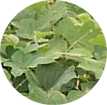"Cotton isn't the king in the South anymore. Kudzu is king!" ~ Channing Cope
 Kudzu first came to America in 1876 from Japan as part of a centennial exhibit in Philadelphia. Gardeners fell in love with fragrant smell of the large green leaves.
Kudzu first came to America in 1876 from Japan as part of a centennial exhibit in Philadelphia. Gardeners fell in love with fragrant smell of the large green leaves.
During the 1940s, journalist Channing Cope believed kudzu, what he called "the miracle vine," would control erosion. Unfortunately, he didn't realize the plant would take to the Southeastern U.S. like a pig in mud. The vine grows too well, overwhelming trees, plants, and everything else it touches. Growing as much as a foot a day during the fertile summer months, over seven million acres in the deep South.
By 1960, the miracle was in desperate need of eradication. A nuisance to many, according to the USDA, the hardy and inescapable twining perennial takes in about 120,000 fresh acres yearly, from Florida to New York, and west to central Oklahoma and Texas.
Declared a weed by the U.S. Department of Agriculture in 1972, kudzu in America has been used for basketry, jewelry, jelly, soap, and hay. Kudzu in Japan, called kuzu, is used in foods and is a treatment for alcoholism. Known in traditional Chinese medicine as ge-gen, the tenacious bean vine has been used for treatment of angina, allergies, and migraine headaches.
U.S. researchers may have found a common fungus, myrothecium verrucaria, to kill kudzu. "I don't know about winning the war with kudzu," said plant pathologist C. Douglas Boyette in a February 2000 interview, "but we're going to do battle with it." The fungus also kills cotton and environmental and toxicological studies are currently underway and may take as long as two years to complete.
In the meantime, headache medicine, anyone?
